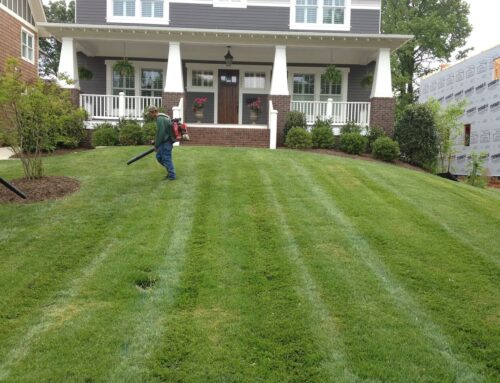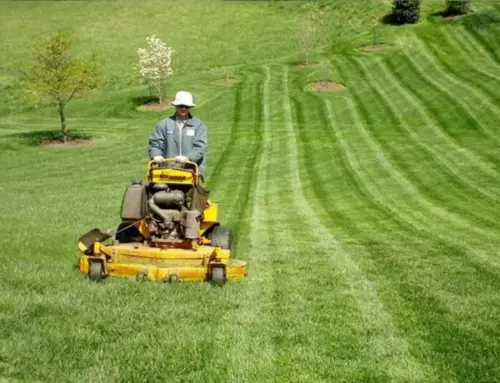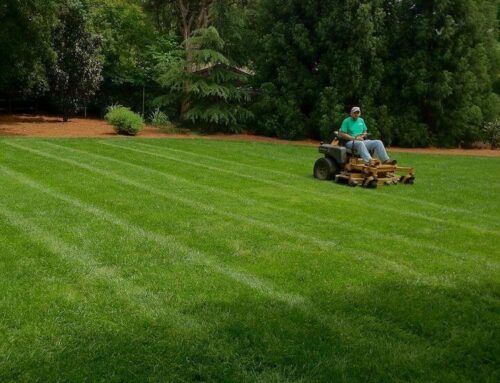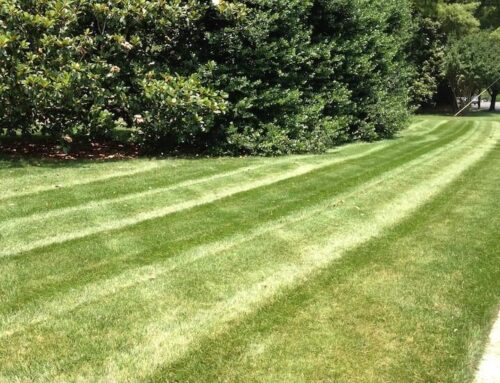If you have spent any time this summer trying to tame your lawn, you know how frustrating it can be to deal with weeds. Nothing seems more disheartening than seeing your once pristine green grass get overtaken by clumps of unwanted broadleaf plants and patches of crabgrass cropping up everywhere you look.
Just when you think you have the upper hand after several exhausting sessions with the weed whacker or herbicide sprayer, a new cluster of weeds pops up seemingly overnight to taunt your lawn care efforts.
As the dog days of summer drag on and your grass struggles under the hot sun, weeds threaten to completely overtake your yard. But do not lose hope yet, lawn care warriors! With some strategic mowing techniques focused specifically on weed control, you still have a fighting chance to reclaim your turf from the weedy invaders.
Keep reading to learn my top tips for battling weeds through your mower.
Regarding weed control, proper watering techniques supplement effective mowing strategies. It’s essential to water deeply yet infrequently, encouraging allowing your grass’s roots to spread out over soil and making them more robust and competitive against weeds. Overwatering, on the other hand, promotes shallow root systems and creates ideal conditions for weed proliferation. Aim to provide your lawn with about an inch of water per week through rainfall or irrigation, and consider using a rain gauge to track lawn watering.
In addition to mowing and watering wisely, fertilizing your lawn judiciously can significantly impact weed management. Utilizing a slow-release fertilizer with the right balance of nutrients for your specific grass type will promote healthy growth and help in outcompeting weeds. It is also important to apply fertilizer at the right time; for example, cool-season grasses benefit most from fertilization in the early spring and fall, whereas warm-season grasses are best fertilized in late spring through summer. Always follow the product’s directions and reduce overfertilization to protect your grass and the environment.
How can proper lawn mowing techniques contribute to effective weed control in your yard?
Proper lawn mowing techniques are integral to an effective weed control strategy. Keeping grass at its ideal height helps to shade the soil, reducing the chance for weed seeds to sprout.
Mow each grass kind at its optimal height and consistently cutting your lawn to this height can significantly strengthen grass blades, giving them an edge over competing weeds.
Additionally, mowing with sharp blades is crucial as clean cuts aid in quick grass recovery and prevent the tearing that can stress the grass and create openings for weeds to take hold.
Moreover, mowing at the right frequency plays a role in weed prevention. Lawns should typically be mowed often enough that removing one-third of the grass blade at a time.
This approach fosters denser grass, which not only looks lush and full but also serves as an effective deterrent to weeds by minimizing the space available for them to establish.
Using proper mowing techniques, you can naturally create an environment where grass thrives and weeds struggle to gain a foothold, reducing the need for chemical herbicides and promoting a healthy, green lawn.
What is the ideal grass height to maintain to prevent weed growth, and how often should you mow your lawn to achieve this height?
The ideal grass height to prevent weed growth varies depending on the type of grass you have in your lawn. However, a general rule of thumb is that your grass should be at a height of approximately six to seven and a half cm (2.5 to 3 inches).
Because of this height, the soil is shaded, which lessens the likelihood that weed seeds will germinate and compete with your grass.
In accordance with the pace of growth of your grass, the frequency of mowing should be determined by weather conditions, soil fertility, and the type of grass can influence. Mowing your lawn once a week during the growing season is an excellent practice to maintain the ideal grass height and promote a healthy lawn.
However, you may need to adjust the frequency based on how quickly your grass grows. It’s important not to remove more than one-third of the complete height of the grass in a single mowing session in order to prevent the grass from becoming stressed.
Are there specific types of lawnmowers or cutting patterns more effective at minimizing weeds in a lawn?
While the type of lawnmower you use and the cutting pattern can contribute to overall lawn health, they may not directly impact minimizing weeds. However, there are certain practices you can adopt to help reduce weeds while mowing:
- Mulching Mowers: Mulching mowers cut grass into fine clippings that can decompose quickly and return nutrients to the soil. This helps promote a healthier lawn, which can compete better with weeds.
- Regular Mowing: Consistent mowing at the appropriate height helps maintain a dense turf, which can shade the soil and inhibit weed growth.
- Varying Mowing Patterns: While this doesn’t directly impact weed growth, changing your mowing patterns can prevent soil compaction and reduce wear on the grass from always mowing in the same direction. This can contribute to a healthier lawn overall.
- Sharp Blades: Using sharp mower blades ensures clean cuts, which reduces stress on the grass and helps prevent weed invasion through damaged grass blades.
- Mowing Timing: Avoid mowing wet grass, as this can spread weed seeds and create clumps of clippings that can smother grass and encourage weed growth.
- Weed Control Practices: Alongside mowing, employing practices such as regular watering, proper fertilization, and overseeing can help maintain a healthy lawn that is more resilient to weed invasion.
While these practices can help minimize weeds indirectly by promoting a healthy lawn, they should be part of a comprehensive lawn care plan that includes targeted weed control methods for persistent weed issues.
What additional practices, such as fertilization or aeration, should be combined with lawn mowing to create a weed-resistant lawn?
To create a weed-resistant lawn, it’s essential to combine lawn mowing with other vital practices that promote overall lawn health and vigor. Here are some additional practices to consider:
- Fertilization: Regular fertilization provides essential nutrients to the grass, promoting healthy growth and competitiveness against weeds. However, using the right amount of fertilizer for your grass type and soil conditions is essential to avoid nutrient imbalances or runoff.
- Aeration: Aerating the lawn helps alleviate soil compaction, improve air circulation, and promote better water and nutrient absorption by the grassroots. This encourages more profound root growth and a stronger, more resilient lawn that can better compete with weeds.
- Overseeding: Overseeding introduces new grass seed into existing turf, filling in thin or bare areas and increasing lawn density. A denser lawn can outcompete weeds by shading the soil and reducing available space for weed seeds to germinate.
- Proper Irrigation: Consistent and adequate watering is crucial for maintaining a healthy lawn. Deep, infrequent watering encourages profound root growth and helps establish drought-resistant turf that can compete better with weeds.
- Weed Control: Implementing targeted weed control measures, such as manual removal, herbicide application, or using pre-emergent herbicides, can help manage existing weeds and prevent new weed growth. Choosing the appropriate weed control method is essential based on the types of weeds present and the specific conditions of your lawn.
- Soil Testing: Regular soil testing can help you understand your soil’s nutrient levels and pH, allowing you to adjust your fertilization and amendment practices accordingly for optimal lawn health.
By combining these practices with regular lawn mowing at the appropriate height, you can create a robust and weed-resistant lawn that looks great and requires less maintenance over time.
Master Lawn Mowing: Essential Weed Control!
Mastering the art of lawn mowing is pivotal for effective weed control. Mow at the right height to keep grass healthy and suppress weeds. Taller grass shades the soil, diminishing weed seed germination and promoting deep root systems, which outcompete weeds for resources.
Frequency is critical—trimming a third of the blade height promotes growth without stress. Sharp blades are crucial; they make clean cuts that heal quickly, preventing weed invasion. Follow these mowing guidelines by Performance Lawn and Landscapes for a luscious, weed-resistant lawn that stands the test of time. Contact us for more information!









